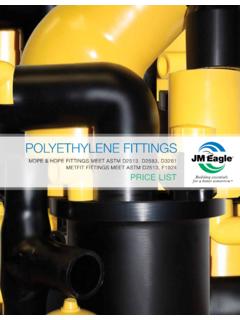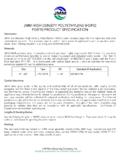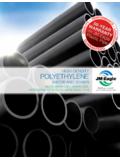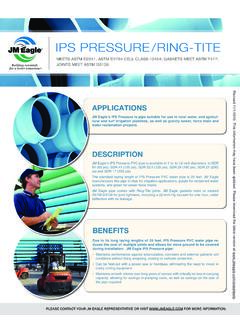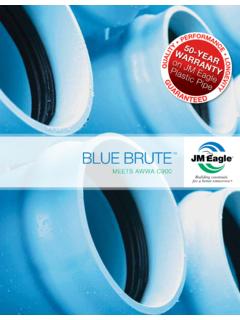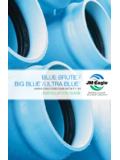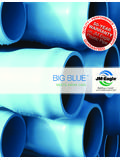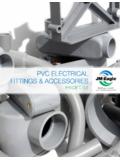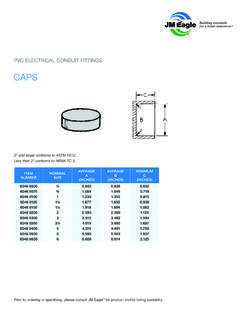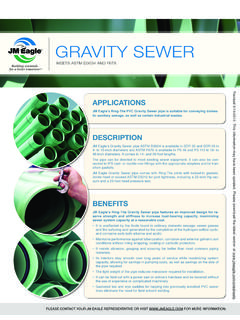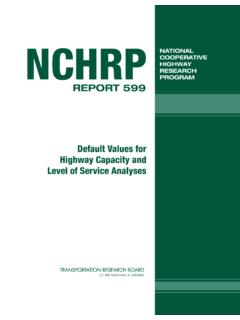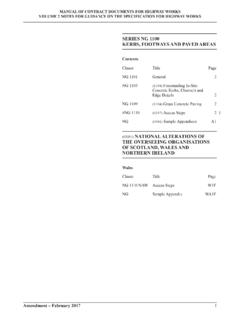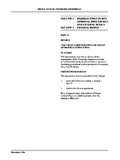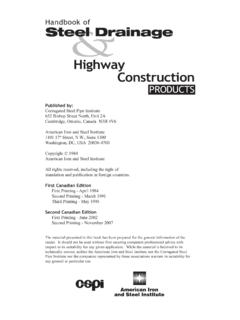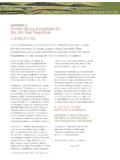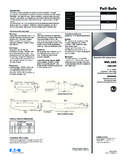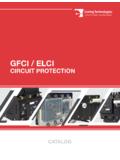Transcription of BULLETIN - JM Eagle
1 DEPTH OF BURIAL FOR PVC PIPETECHNICALBULLETINB uilding essentials for a better tomorrow JANUARY 2009 FLEXIBLE PIPE THEORYPVC pipes are classified as flexible pipes. They flex without breaking when loaded externally from soil weight and vehicular traffic. Rigid pipes, such as those made of concrete or clay, do not perceptibly flex when loaded and experience wall crushing when their load limit is reached. This mode of failure for rigid pipes has given rise to the terms crush strength and D-Load , but these terms do not apply to PVC a PVC pipe encounters external loading, its diameter will begin to deflect, meaning its sides will move outward and slightly downward.
2 If the pipe is bur-ied in supportive soil, the stiffness of the soil will resist the deflection (see Figure 1). This action and reaction is the key to how a PVC pipe carries external 1 FLEXIBLE PIPE DEFLECTIONThe combination of the embedment soil stiffness and the pipe stiffness form a system that acts to support external loads. By itself, the pipe may not support much weight, but the soil/pipe system can have tre-mendous load capacity. A PVC pipe s resistance to deflection in an unburied state is measured by its pipe stiffness . Pipe stiffness is usually less significant than soil stiffness in PVC pipe installations, but in general, a higher pipe stiffness results in a higher load stiffness is most affected by the level of compac-tion achieved, and to a lesser extent by the soil type.
3 Soil stiffness values for various conditions and soil types have been derived through extensive ALLOWABLE BURIAL DEPTHB ecause a PVC pipe flexes rather than breaks when loaded, the failure criterion is not fracture strength. Instead, a limit is placed on pipe diametric deflection. This limit is expressed in terms of percentage reduction in diameter due to external loading. Industry recommen-dations for maximum deflection are shown in Table 1 MAXIMUM RECOMMENDED DIAMETRIC DEFLECTION PVC Pressure Pipes 5% PVC Sewer / Drain Pipes 7 % PVC Electrical Conduits 5%A failure of a flexible pipe system from external load-ing is defined by the point at which the top of the pipe begins to experience inverse curvature.
4 Research has shown this point occurs at a minimum of 30% deflec-tion; recommendations for maximum deflection there-fore incorporate safety factors of 4:1 or 6 PIPEDEFLECTEDFLEXIBLE PIPE Page 1 of 4In order to determine the suitability of a particular burial depth, a system designer estimates the pipe deflection through the use of an empirical equation called the Modi-fied Iowa Equation . A simplified, conservative version of the equation is presented below:MODIFIED IOWA EQUATION (W + P) 100 % DEFLECTION = (PS) + Where:% DEFLECTION = predicted percentage of diametric = Live Load (lbs/in2): pressure transmitted to the pipe from traffic on the ground surface.
5 Live Load values are found in Table = Prism Load (lbs/in2): pressure acting on the pipe from the weight of the soil column above the pipe (also called Dead Load ). Prism Load values are found in Table = Pipe Stiffness (lbs/in2): a flexible pipe s resistance to deflection in an unburied state. Pipe Stiffness values for JM Eagle products are found in Table = Modulus of Soil Reaction (lbs/in2): stiffness of the embedment soil. Values for Modulus of Soil Reaction are found in Table 2 LIVE LOADS ON PVC PIPEHEIGHT OF COVER (FT)LIVE LOAD TRANSFERRED TO PIPE, (LBS/IN2)HIGHWAY H2O1 RAILWAY * * * * * * * * * *28* *30* *35**40**1 Simulates 20 ton truck traffic + Simulates 80,000 lb/ft railway load + 180,000 lbs.
6 Dual tandem gear assembly; 26-inch spacing between tires and 66-inch center-to-center spacing between fore and aft tires under a rigid pavement 12 inches thick + impact.* Negligible live load influence. Page 2 of 4 Table 3 PRISM LOAD SOIL PRESSURE (LBS/IN2)HEIGHT OF COVER (FT)SOIL UNIT WEIGHT (LBS/FT3) Page 3 of 4 Table 5 AVERAGE VALUES OF MODULUS OF SOIL REACTION, E (FOR INITIAL FLEXIBLE PIPE DEFLECTION)PIPE BEDDING MATERIALSE FOR DEGREE OF COMPACTION OF PIPE ZONE BACKFILL (PSI)SOIL CLASSSOIL TYPE(Unified Classification Systema)
7 LooseSlight < 85% Proctor, < 40% relative densityModerate 85% - 95% Proctor, 40% - 70% relative densityHigh > 95% Proctor, > 70% relative densityClass VFine-grained Soils (LL>50)b Soils with medium to high plasticity CH, MH, CH-MHNo data available; consult a competent soils engineer; Otherwise use E = 0 Class IVFine-grained Soils (LL < 50)Soils with medium to no plasticity CL, ML,ML-CL, with less than 25% coarse-grained particles502004001,000 Class IIIFine-grained Soils (LL < 50)Soils with medium to no plasticity CL, ML,ML-CL, with more than 25% coarse-grained particles 1004001,0002,000 Coarse-grained Soils with Fines GM, GC, SM, SCC contains more than 12% fines1004001,0002,000 Class IICoarse-grained Soils with Little or No Fines GW, GP, SW, SPC contains less than 12% fines200 1,000 2,000 3,000 Class ICrushed Rock1,000 3,000 3,000 3,000 Accuracy in Terms of Percentage Deflection 2 2 1 a ASTM Designation D 2487, USBR Designation E-3 b LL = Liquid limit c Or any borderline soil beginning with one of these symbols ( GM-GC, GC-SC)
8 D For 1% accuracy and predicted deflection of 3%, actual deflection would be between 2% and 4%. Note: Values applicable only for fills less than 50ft (15m). Table does not include any safety factor. For use in predicting initial deflections only; appropriate Deflection Lag Factor must be applied for long-term deflections. If bedding falls on the borderline between two compaction categories, select lower E value or average the two values. Percentage Proctor based on laboratory maximum dry density from test standards using about 12,500 ft-lb/cu ft (598,000 J/m3) (ASTM D 698, AASHTO T-99, USBR Designation E-11).
9 1psi = : Soil Reaction for Buried Flexible Pipe by Amster K. Howard, Bureau of Reclamation, Denver Colorado. Reprinted with permission from American Society of Civil Engineers Journal of Geo-technical Engineering Division, January 1977, pp. , PP. pipe system designer uses this equation to predict PVC pipe deflection given type of PVC pipe, burial depth, soil density, type of traffic, type of embedments oil, and compaction density of embedment soil. The designer then compares the predicted deflection to there commended maximum deflection in Table 1 to check if the burial depth is 1: Shallow BurialA pipe system designer is interested in using ASTM D3034 SDR 35 PVC sewer pipe in a shallow-burial installation with the following characteristics: -1 foot burial depth:- 120 pounds per cubic foot soil density- H20 highway traffic- sand embedment material- 90% Proctor density embedment soil compactionThe maximum predicted deflection is , well below the maximum recommended for PVC sewer pipe in Table 1 of 7 %.
10 Minimum Burial Depth: The minimum recommend-ed burial depth for PVC pipes beneath a highway is one foot. This recommendation assumes proper specifi-cation of embedment materials and compaction, and proper 2: Deep BurialA pipe system designer is interested in using ASTM D3034 SDR 35 PVC sewer pipe in a deep-burial instal-lation with the following characteristics:- 45 foot burial depth- 120 pounds per cubic foot soil density- H20 highway traffic (Note: Live loads are negligible for deep burials)- sand embedment material- 90% Proctor density embedment soil compactionThe maximum predicted deflection is , well below the maximum recommended for PVC sewer pipe in Table 1 of 7 %.
